Autumn Insect Migrations
An unseasonably cool summer in the Midwest makes it difficult to think about the upcoming change in season but fall is just around the corner.
With the cooler temperatures, comes the threat from a group of fall pests. We call these pests, fall invaders and they survive the winter through the protection afforded by structures. They migrate towards buildings in search of a warm resting spot to spend the cold winter. This resting spot may include the wall, ceiling and attic voids of buildings.
Changes in daylight hours and cooler temperatures can trigger the fall invaders indoor movements. Normally there is a single life stage, the adult stage, which moves indoors. During their winter stay, they do not breed, feed or develop. Examples of the most common insects which use this winter survival tactic include: multicolored Asian lady beetles, cluster flies, and box elder bugs. More recent invasive invaders to add to the list include the brown marmorated stink bug and kudzu bug.
A second type of fall invaders arrives in our structures more by accident. These insects may be attracted to building lighting and may be tied to harvesting of fields. The majority of these are mold feeders which are associated with grain in poor condition. Examples of these beetles include the foreign grain beetle, and hairy fungus beetle. In the Midwest, these insects have already started to appear in buildings but will peak in the month of September.
These insects, just by their numbers can elevate beyond nuisance status, especially in sensitive environments like food production plants, pharmaceutical plants and health care facilities where insect contamination is a concern. Some can stain surfaces and create offensive odors in addition to being a nuisance and contamination threat.
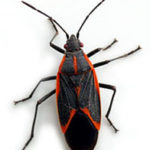
Box Elder Bugs
Probably the most common of the fall invading insects, this black and red marked bug feeds on trees including the box elder and maple. It is ½” long as an adult, mostly black in color with red lines marking the wings and the thorax or area behind the head.
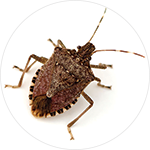
Brown Marmorated Stink Bug
This insect is relatively new to the United States and has caused major issues on the east coast. It has also been shipped in commerce to other parts of the country and continues to threaten to move westward. It is both an agricultural pest and structural pest. Adults are brown in color, 5/8” in length and a body shape which is shield-like. They can be identified from similar species of stink bugs by the light bands on the antennae and around the outer margins of the body.
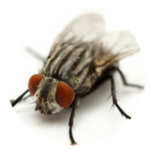
Cluster Fly
There are several flies which will overwinter in structures. Cluster flies and face flies are the most common and tend to cause the most concern since they often appear in groups or clusters. The adult cluster fly is slightly larger than a house fly. The wings are held overlapping each other over the abdomen unlike the house fly, whose wings appear to be more of a triangular pattern when at rest. It has golden yellow hairs on the thorax or main middle section of the body. The immature stages are parasitic on earth worms and cause no structural harm.
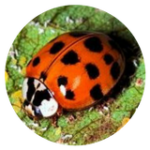
Multicolored Asian Lady Beetle
These beetles get their name because they can vary in color and markings. The wing color can vary from tan to reddish orange and they can have a varied number of black spots on the wings. These insects are predaceous on soft bodied plant pests like aphids, and have a valuable role in reducing agricultural and horticultural pests. They achieve pest status as they migrate indoors in the late fall months. They are sometimes called the Halloween beetle because they often come into structures around the time of Halloween on a sunny day after a frost. These beetles are more attracted to structures with contrasting colors such as light colored siding and dark trim.
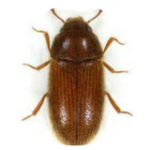
Hairy Fungus Beetle
The hairy fungus beetle is associated with mold and is light attracted. One common species we find in food plants can be confused with the cigarette beetle due to its size, color and shape. It is oval in shape with a three clubbed antennae. The antennae of the cigarette beetle are saw-like in shape and not clubbed.

Foreign Grain Beetle
The foreign grain beetle is a common late summer and fall invader. It feeds on grains in poor condition and the fungus associated with the deteriorating grain. They are 1/16”- 1/8” in size. They look similar to flour beetles in color and body shape but are smaller and more attracted to lights. You may find these beetles in large numbers in insect light traps.
Prevention Tips for Fall Invaders
First Line of Defense: Exclusion
Ideal temperatures for fall invading insects overwintering locations are in the 40-50 F range which is typically found in the exterior wall voids or attic spaces of buildings. Denying the insects access for these ideal harborage sites is the first line of defense in control. Use of sealants, door sweeps and screens are the primary exclusion tools in preventing entry. The table below shows the estimated time frames for the fall invading insects to move into and out of structures. This table can be used to help plan proper sealing times. It is best to seal after insects leave the building and before re-entry in the fall or late summer. Indoor migration timetables will vary based on geographical location.
Fall Invader Timetable
| Insect | Enters Structure | Leaves Structure |
|---|---|---|
| Boxelder Bugs | September | March – April |
| Cluster Flies | Late August – September | March – April |
| Asian Lady Beetle | October | March – April |
Reduce Attraction
Since some of these insects, like the foreign grain beetle, can be attracted to structures by light, light management is considered another important step. Mercury vapor lights are more attractive to insects than sodium vapor lights. For this reason, low pressure sodium vapor lights are preferred. Newer, LED lights can offer another option. Be sure to select LED lights with the spectrum similar to the low pressure sodium lights. If mercury vapor lights are used, it should be as part of a push pull strategy. Place these lights around the property perimeter to pull insects away from the building. Use the high pressure sodium vapor lights closer to the building. Many of the fall invaders will be attracted to areas of the building where there are contrasting colors. So the juncture where a dark brown window frame meets a pale brick building will be attractive. Although it may be impractical to paint or change the building color, this knowledge can be useful in making sure that these areas of contrast are effectively sealed.
| Type of Light | Sepectrum | Visible Light |
|---|---|---|
| Mercury Vapor Lighting | 450-500 nm | Blue/White |
| High Pressure Sodium Vapor Lighting | 575-600 nm | Yellow/White |
Insecticidal Control
Perimeter treatments with insecticides can be used to supplement exclusion efforts. The applications should be made to areas where the insects are resting and entering the building. Timing of the applications can be critical to achieving good control.
Physical Removal
If the timetable for exclusion and preventative pesticide treatment was not met and the insects make their way unrestricted, insect light traps may be helpful in attracting and eliminating some of the insects which are not confined in ceiling or wall void spaces. Occasionally, a number of the invading insects will wind up in the occupied spaces of the building due to their point of entry or they may emerge in winter due to a temporary “January thaw” situation in belief that it is spring time. Smaller portable, battery operated light traps can be useful in small areas for attracting insects and may offer some relief. In addition to light traps, insects can also physically be removed through the use of vacuums. If vacuums are used, the contents should be discarded right after vacuuming has been completed. Some of the fall invaders can release foul odors and prolonging their time in the vacuum can taint the vacuum.
Have a Pest Problem? Contact McCloud Services to help you today!
Request a Quote
Please submit your contact information below and a McCloud Services representative will contact you.
